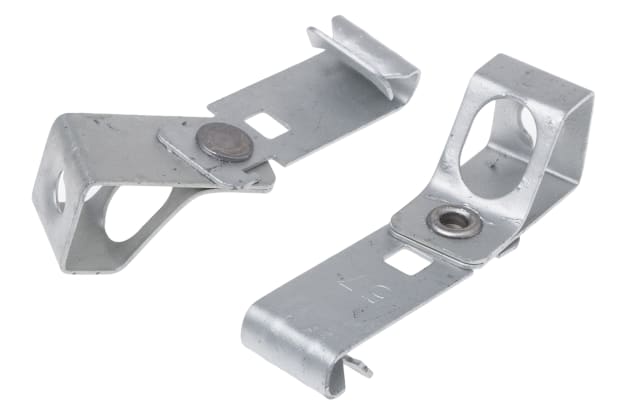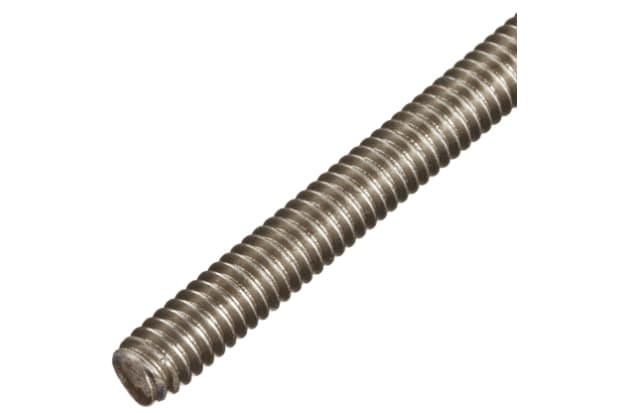- Published 6 Mar 2024
- Last Modified 16 May 2024
- 9 min
A Complete Guide to Threaded Rod
Our threaded rod guide explores its uses, types, sizes, characteristics, load capacity, materials, and more.

This expert guide on screw rod and threaded bar studding is designed to explain exactly what threaded rod is. We will also cover how it is used, what types and sizes are available, what materials it is usually made from, and how to cut and work with threaded rod.
What is Threaded Rod?
Threaded rod, also known as threaded bar, threaded studding or screw rod, is a common fastener type. It is used much the same way as a very long, thick bolt or screw. Screwed rod threading might run the full length of the stud (all-thread), or partway along from both ends.
Threaded rods and stud bolts are widely used wherever a fastener of greater length and rigidity is needed to secure two items together. They are often found securing wood or metal items together or being used to give additional strength to structures supported by concrete and other materials. The threading makes it easy to attach nuts and other fixings to the rod as required.
You will find a wide variety of sizes, gauges and load capacities available to suit all kinds of jobs. Some varieties may have a drive slot in one end, making them easier to install, although most studding does not feature a head in the same way that most bolts and screws do.
What is Threaded Rod Used for?
As a popular subtype of fasteners and fixings, threaded rod uses are many and varied. They are commonly used in professional construction work, repair and maintenance, production and processing, and various other demanding industrial applications.
Among the industries most commonly associated with regular use of threaded bar studding are:
- Construction
- Automotive assembly and repair
- Manufacturing, production and processing facilities
- Electrical installation
- Plumbing and contracting
- Agricultural uses
- Plant maintenance
- Medical machinery
- Marine applications and engineering
One of the reasons why steel and stainless steel threaded rod is often used is that it is generally cheap, easy to work with, and neat and tidy to install. However, steel will corrode when used outdoors. Grade 316 stainless steel is resistant to corrosion, making it the best material for outdoor use and marine environments. It is also a suitable choice for fastening and pinning materials in a wide range of damp, humid or environmentally challenging settings.
Threaded Rod Types & Characteristics
There are several standard types of threaded rod, each chosen for its own set of characteristics, features and functions. Some of the more widely used stud bar varieties include:
Fully Threaded Stud Bolts
These have the threading running along the full length of the rod, allowing nuts and other fixings to mate fully at any point along the bar.
Double-End Threaded Rod or Double-Ended Threaded Bar
These have a length of threading at either end of the stud but are not threaded right the way up the centre. The threaded segments are of equal length at both ends.
Tap-End Studding
This will look similar to double end studs, but the threaded portion is longer at one end than at the other.
Hollow Threaded Rod
This type is hollow along the full length of the stud, with openings at either end. This allows cables and other components to pass through the body of the rod, for example when being used to mount a light fixture.
Fine Threaded Rod or Fine Pitch Threaded Rod
This term generally applies to studding whose threads are thinner and closer together than standard or coarse varieties. This can be an advantage in install locations subject to vibration, making it less likely that the rod will start to work its way out. Fine threads also offer greater tensile and shear strengths than coarse threading.
Threaded Rod Connectors
A threaded rod connector is a type of fixing that looks a lot like an elongated nut. They are threaded on the inside walls and can be affixed onto a length of screw rod in the same way as a standard nut.
The threaded rod coupler (sometimes called a threaded rod end fitting) is positioned such that one end of a piece of stud bar is inserted about halfway into the fixing. The end of the second piece of screw rod is then inserted into the opening at the other end of the connector and the two pieces are then securely joined and extended.
Threaded Rod Hangers

A threaded rod hanger is often used in installations where the rod itself needs to be suspended below a solid wood or masonry surface, rather than passing through it. Concrete ceilings and hollow floors are common examples of places in which a system of threaded rod hanger brackets might be used.
These hangers work like drop-in anchor points and are driven into the surface below which the rod needs to hang. At the other end from their thread-cutting tips, they usually feature either a screw-in or clip mount which serves as an attachment point or flange for the threaded rod itself.
Most threaded rod hangers are self-tapping, although a range of clip-in versions is also available for light-duty installations.
How to Use Threaded Rod?
Using threaded rod is simple for anyone who has previously worked with various types of large screws and bolts, particularly carriage bolts. Stud bar works a lot like many types of standard bolts, with a few small differences.
For one thing, threaded rod is usually chosen in applications where the required length far exceeds that of most conventional screws or bolts. It is not at all unusual for 2’ or 3’ lengths of threaded rod to be used in heavy-duty or structural applications. Much thicker gauges tend to be widely available when shopping for screw rods than for even the largest commercial anchor bolts.
Whereas most bolts are only threaded at one end, true threaded rod more commonly features threading along its full length or at both ends. Unlike bolts, the required sections of threaded rod are typically cut to size from a longer piece, meaning that in most applications the threaded rod will not feature any type of head for hammering or driving the section more easily.
Aside from these differences, the actual method for installing a threaded bar is very similar to that for installing a bolt or screw. The precise step-by-step method for installing threaded rod as an anchor or pin will depend on the material you are driving it into. For certain materials like concrete and masonry, you will usually need to use a hammer drill and some form of adhesive anchor, as well as the rod itself.

How to Cut Threaded Rod?
When working with thread bar and studding, it is always useful to know how to cut threaded rod to the required length neatly and safely. The best way to do this is with a dedicated threaded rod cutter.
These can either be manual or powered. Manual (handle-operated) versions tend to use bladed jaws, which can often be swapped out to make neat cuts through various thicknesses of stud. Powered versions more commonly rely on some form of spinning disk to make neat cuts. Threaded bar can also be trimmed to length on a mitre saw or chop saw, provided that a suitable metal cutting disk is installed.
Threaded Rod Sizes
Some common sizes of threaded rod (thread size, length and thickness) are listed below. You may need to cut your thread bar to length for specific projects after buying it - standard lengths for buying threaded rod online include 3’, 6’, 10’ and 12’ sections.
Some of the most common sizes for buying threaded rod online include:
- Threaded rod M10
- M3 threaded rod
- Threaded rod M12
- M4 threaded rod
- M25 threaded bar
- M8 threaded rod 2m
- M16 x 1.5 threaded rod
- Threaded rod m16
- M24 threaded rod
- Large threaded rod
- M10 threaded rod tensile strength
- M19 threaded rod
- Large diameter threaded rod
- M9 threaded rod
- 24mm threaded bar
- 7mm threaded rod
- 12 mm all thread
- 4mm threaded rod
The M (metric) sizing of threaded rod refers to a standardised diameter and is normally featured prominently on most UK stud bar fasteners and fixings.
Thread Size (Thread Count and Thread Pitch)
Thread pitch refers to the distance, measured side-to-side, between any two thread crests (the widest part of the threading that extends outwards from the core of the rod).
Lower thread pitch means higher thread count because the threads are physically closer together. Thread count refers to the number of crests on a given section of rod and is measured in TPI (threads per inch).
Note that threading on screw bar can be cut in either a right-handed pattern (the standard clockwise to tighten arrangement) or left-handed variants.
Threaded Rod Sizes Chart
This chart shows common metric thread sizes:
Thread Size | Major Diameter | Thread Pitch (mm) | Tapping Drill Size |
|---|---|---|---|
M3 | 3 | 0.5 | 2.5 |
M4 | 4 | 0.7 | 3.3 |
M5 | 5 | 0.8 | 4.2 |
M6 | 6 | 1 | 5 |
M8 | 8 | 1.25 | 5.8 |
M10 | 10 | 1.5 | 8.5 |
M12 | 12 | 1.75 | 10.2 |
M16 | 16 | 2 | 14 |
M20 | 20 | 2.5 | 17.5 |
Threaded Rod Load Chart
The below chart shows the typical minimum load capabilities for steel threaded rods of different sizes. Please note that the minimum proof load has been calculated based on threaded rod with a property class of 4.6.
Thread Size | Stress Area (mm²) | Minimum Proof Load (kg) |
|---|---|---|
M3 | 5 | 112 |
M4 | 8.8 | 204 |
M5 | 14.2 | 326 |
M6 | 20.1 | 459 |
M8 | 36.6 | 836 |
M10 | 58 | 1335 |
M12 | 84.3 | 1937 |
M16 | 157 | 3598 |
M20 | 245 | 5617 |
Threaded Rod Materials
Threaded rods come in several different materials, with the best choice depending on various factors. These typically include what you need the stud to do, the environment where it will be installed, and which types of materials the anchor pin is going to be securing.
Note that you will also need to be acutely conscious of the load-bearing properties and requirements that anchors used in your project will have to meet or exceed.
Mild steel threaded rod is one of the most common types. Various sorts of steel and derivative materials are typically used in the manufacture of screw rods. Stainless steel (SS threaded rod) is another common type, as is galvanised threaded bar. The latter is zinc plated for added protection against corrosion, making it ideal for use when exposed to harsh conditions or humid environments over prolonged periods.
You can also buy brass and nylon threaded bar, although this tends to be used at smaller gauges where lower forces are in play. These materials are not suitable for any sort of critical structural application.